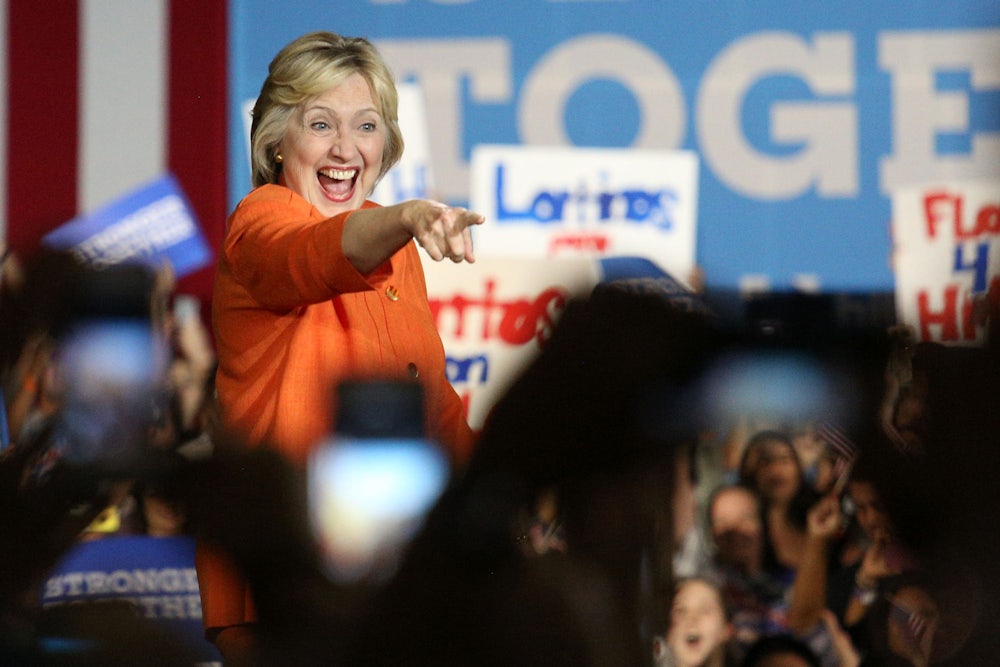Hillary Clinton entered the 2016 primaries as both the Democratic Party’s likely next president and, incongruously enough, the living symbol of a past that liberals were eager to relegate to history’s dustbin. She was the Wall Street Democrat facing the rise of economic populism; the tough-on-crime stalwart amid an invigorated movement for criminal justice reform; the gung-ho free trader at a time when nearly two-thirds of Americans think trade deals need to be restricted. She was just so ’90s.
Sixteen months later, Clinton has been reborn as a paragon of twenty-first-century liberalism. She’s the Democratic nominee running on the boldest platform the party has put forth since 1972. And after their made-for-TV display of party unity in Philadelphia, the Democrats are stuck with her, for better or worse, in scandal or in health. But as happens in all marriages of convenience, the second thoughts are beginning to set in. Can Clinton be trusted to follow through on her new set of promises? Won’t her old instincts of triangulation and compromise reassert themselves if she makes it to the White House?
The answer is: not if liberals are as clear-eyed about Clinton’s faults as she tends to be about gauging the political winds of the moment. The trouble with Clinton is not so much her congenital “moderation.” It’s that she is the Silly Putty of American politics: malleable and shapeless, taking on the imprint of whoever presses hard enough against her. But that, if liberals play their cards right, could prove to be her greatest virtue.
Clinton has been America’s champion shape-shifter for more than half a century. She has morphed, over time, from a Goldwater Girl to a McGovernik, from a feminist to a woman who stands by her man, from a centrist eager to move the party to the right to a born-again liberal crusader. To fend off her surprisingly robust primary challenge from Bernie Sanders, Clinton largely signed on to his “revolution,” at first with reluctance and then with relish.
It’s hard to think of another American politician who has had so many makeovers. There have been more New Hillaries by now than there were New Nixons. If the Clinton of the 1990s and early 2000s bore the heavy imprint of the Wall Street Journal editorial page, the new Clinton seems to have been impressed upon an issue of The Nation. Annie Oakley Clinton has become Gun Control Clinton, Gordon Gekko Hillary a Wall Street reformer, Milton Friedman Hillary a fair trader vowing to block the job-killing Trans-Pacific Partnership. The politician who famously warned of “super-predators” now echoes the chant, “Black Lives Matter.”
It would be sheer folly for Democrats to imagine that Clinton’s latest identity will somehow be indelible. Given her shape-shifting history, what can liberals hope for from a President Clinton? Is distrust the only option?
In one important sense, it is. But that’s no reason for despair or resignation—quite the contrary. Clinton has now shown that she can be moved left just as effectively as she was once moved right. Her vaulting opportunism, her Silly Putty politics, might turn out to be the very quality that makes her able to adapt to the rising expectations of the Democratic base. If liberals learn the right lessons from the way Clinton has been successfully pressed and pulled over time in different political directions, they may be able to convert her opportunism into their opportunity.

Elizabeth Warren used to love telling a story that vividly illustrates Hillary Clinton’s slipperiness. In 1998, when Warren was a Harvard professor and Clinton was first lady, Warren wrote a New York Times op-ed warning against a proposed “bankruptcy reform” law that would make it harder for those with credit-card debt to get relief. After Clinton read the op-ed, she reached out. The two women met in a “tiny room,” as Warren recounted last November to Bill Moyers, in the “bowels” of a Boston hotel. Over hamburgers and french fries, Warren offered a quick tutorial on bankruptcy law. “I never had a smarter student,” Warren recalled.
The first lady became a convert to Warren’s cause, convincing her husband to veto the bankruptcy bill. But after Clinton became a senator from New York, Republicans revived the measure and Clinton voted “yes.” Warren’s take on Clinton’s reversal was unsparing: “Big banks were now part of Senator Clinton’s constituency,” she wrote in her 2003 book, The Two-Income Trap. As first lady, Clinton had been “willing to fight for her beliefs.” But “as New York’s newest senator, it seems that Hillary Clinton could not afford such a principled position.”
But the story didn’t end there. This year, Clinton ended up courting Warren’s support for her presidential bid. Her antagonist now has her ear. Warren could repurpose her cautionary tale as a lesson for how liberals should approach a Clinton presidency. She didn’t stay silent about what she saw as Clinton’s betrayal. She didn’t worry that she’d be excluded from Clinton’s circle in punishment for her dissent. She pressed hard. And ultimately, Hillary paid heed, and drew Warren back in.
It’s a curious fact about both Clintons that they reserve their greatest respect not for their friends, but for their erstwhile enemies, whom they actively try to win over. David Brock, who made his name in the ’90s as the man who penned fabulist accounts of Clinton scandals for The American Spectator, is now a star of the Clinton universe, his Media Matters web site the campaign’s ally in counterpunching against its right-wing critics. The late billionaire Richard Mellon Scaife, a major purveyor of the Vince Foster conspiracy theories, became an ardent Clintonista. And when Hillary transitioned from first lady to senator, she buddied up to some of her husband’s chief Republican antagonists, including John McCain and Sam Brownback.
The lesson here isn’t just that Clinton is a shape-shifter, but that it pays to oppose her. Those who have stood up to her the most forcefully and relentlessly—from Newt Gingrich to Bernie Sanders—have reaped political dividends. The left must now do the same, to ensure that she keeps the ambitious promises she’s making as a candidate.
What will work best to keep up the pressure? For starters, nothing works on Clinton like the threat of political annihilation. The prospect of another challenger from the left in 2020 might do wonders to keep her in line. Early in her presidency, either Sanders or another left-wing stalwart should issue a blunt message: If Clinton backslides, if she starts to revert to ’90s Hillary, she’ll be met with a serious Democratic opponent. Groups like MoveOn can also take a page from the Tea Party’s book and threaten to primary any Democrat in Congress in the 2018 midterms who supports Clinton in trying to water down Wall Street reforms or renege on her opposition to the Trans-Pacific Partnership.
Clinton has also shown that she can be moved by pressures from outside the political system. Last August, when Black Lives Matter threatened to disrupt a Clinton campaign event in New Hampshire, she arranged to meet in private with BLM activists. An often heated discussion ensued, with Clinton insisting that the group needed a more traditional, detailed policy agenda, while her interlocutors resisted what they saw as the trap of pragmatic politics as usual. But the upshot was telling. It wasn’t just that Clinton began to give increasing prominence to BLM’s policy positions, like reforming mandatory minimums and abolishing private prisons. She began to frame criminal justice issues in a more radical manner, talking about “systemic racism” as the underlying problem, instead of simply riffing through a laundry list of flawed policies.
The burgeoning social movements of the left should take a cue. The historical record is clear: Progress in America happens when militant social movements are willing to make life uncomfortable for liberal presidents, whether it be the sit-down strikes of the 1930s or the civil rights marches of the 1960s. Activists now have more tools in their political box, thanks to their online networks. Environmentalists, for instance, scored big by making the Keystone pipeline the target of their ire, combining targeted protests with online pressure campaigns to make it clear that Democrats—Clinton among them—couldn’t count on their vote until they landed on the right side of the issue.
Would President Clinton be annoyed by constant, nagging pressure from her left? Would her ferocious loyalists denounce the ungrateful dissidents for undercutting party unity in the face of Republican opposition? Yes, no doubt, on both counts. But if the left takes a chapter from Warren, from BLM, and from Sanders—and from the countless centrists and right wingers who have pressed their issues and images onto her for decades—Clinton may actually end up thanking them for the pressure.
A Silly Putty presidency, by definition, isn’t likely to be a consequential one—certainly no more than that of the shape-shifting President Clinton who came before. Hillary, for all her instinctive caution, will want to leave a legacy more substantial than her husband’s. The left can play not only on her malleability, but on her ambition. And if they can effectively mold her into the shape of American politics to come, Hillary Clinton may yet wind up in the history books as an FDR for our times.
